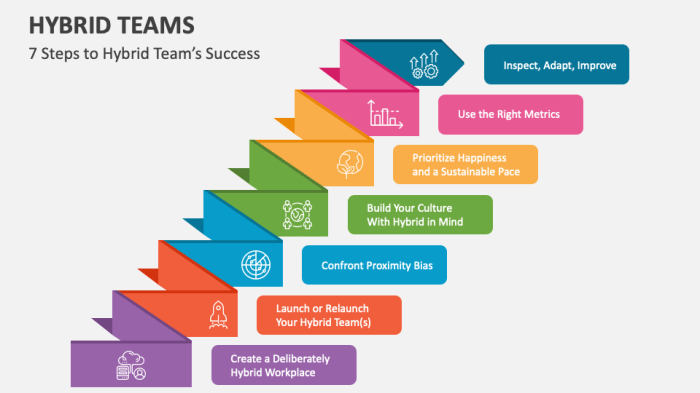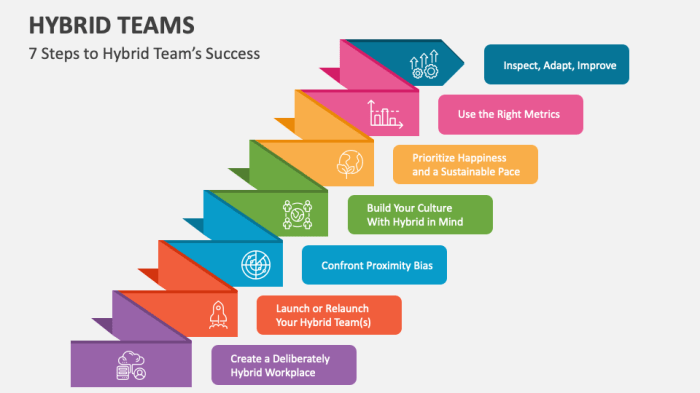
How to master hybrid remote teams is a critical skill in today’s dynamic work environment. This isn’t just about juggling schedules and tools; it’s about building a thriving, productive, and connected team across different locations and work styles. From defining the nuances of hybrid work arrangements to optimizing communication strategies, we’ll explore actionable steps to cultivate a high-performing remote team.
This comprehensive guide dives into the key aspects of successful hybrid teams, from defining the structure and communication styles to maximizing productivity and resolving conflicts. We’ll examine communication strategies, collaboration techniques, and essential technologies for a seamless experience. Discover how to create a supportive and inclusive environment that encourages innovation and growth in your hybrid team.
Defining Hybrid Remote Teams
Hybrid remote teams represent a significant shift in the modern workplace, blending the advantages of in-office and remote work. This flexible approach aims to optimize productivity, employee satisfaction, and company culture, while acknowledging the evolving needs of a diverse workforce. Understanding the intricacies of hybrid models is crucial for effective management and team cohesion.Hybrid remote teams are characterized by a combination of in-office and remote work, with employees working part of their time in the physical office and part of their time from a remote location.
This contrasts with fully remote teams, where all work is performed remotely, and in-office teams, where all work is performed in a shared physical space. The key difference lies in the flexibility and choice offered to employees, allowing for a more personalized and adaptable work style.
Hybrid Work Arrangements
Different companies implement hybrid models with varying degrees of flexibility. Common arrangements include a set number of days in the office, such as two days in-office and three days remote, or flexible schedules that allow employees to choose their work location based on project needs or personal preferences. The frequency and pattern of in-office and remote work can be determined by factors such as industry, company culture, and individual employee needs.
Mastering hybrid remote teams is all about thoughtful planning and communication. Crucially, you need to ensure your IT infrastructure supports seamless collaboration, like exploring how to effectively “give mobility a seat at the IT table” giving mobility a seat at the IT table. This means prioritizing reliable remote access, robust communication tools, and flexible workspaces to empower team members for optimal productivity and engagement.
Ultimately, that’s the key to successful hybrid remote work environments.
Types of Hybrid Work Arrangements
- Two days in-office, three days remote: This arrangement provides a balance between in-person collaboration and independent work. It allows for face-to-face interactions and team building, while maintaining the flexibility of remote work for focused tasks or personal needs. An example of a company successfully implementing this model is [company name], which reported improved productivity and employee satisfaction.
- Flexible schedules: This model provides the most autonomy to employees. Teams may work from home, the office, or a combination, depending on project demands or personal preferences. This flexibility often fosters a strong sense of trust and autonomy within teams. For example, [company name] allows employees to work from home on days they need to attend to personal commitments, increasing employee satisfaction.
- Rotating schedules: Teams may rotate their work locations weekly or monthly, to allow employees to experience both the collaborative aspects of the office and the focus and autonomy of remote work. This structure allows for increased adaptability to team needs and helps to prevent burnout.
Evolving Nature of Hybrid Work Models
The hybrid work model is constantly evolving. Initially, it was a response to the pandemic, but it’s now a more permanent fixture in the workplace. Companies are increasingly recognizing the benefits of flexibility, such as increased employee satisfaction and productivity, and a more diverse talent pool. Hybrid work is adapting to specific industry needs and organizational structures, with some companies adopting more flexible and individualized models than others.
The implications for team dynamics are multifaceted, requiring companies to develop new communication strategies, redefine team norms, and address potential challenges.
Communication Strategies
Navigating the complexities of hybrid work demands a robust communication framework. Effective communication isn’t just about transmitting information; it’s about fostering understanding, collaboration, and a sense of shared purpose among team members spread across different locations and time zones. This requires intentional strategies and the right tools to ensure everyone feels connected and included.Clear and consistent communication builds trust and reduces misunderstandings, especially in a hybrid environment where visual cues and spontaneous interactions are limited.
By establishing clear protocols and utilizing the right tools, hybrid teams can overcome the challenges of distance and maintain a high level of productivity and engagement.
Effective Communication Framework
A strong communication framework in a hybrid team relies on proactive communication, clear guidelines, and a range of tools to suit various needs. Team members need to understand how to communicate effectively, both synchronously and asynchronously, to maintain productivity and collaboration.
Communication Tools and Platforms
Different communication tools cater to various needs within a hybrid team. Choosing the right tool depends on the context and purpose of the communication.
- Video conferencing platforms like Zoom, Google Meet, or Microsoft Teams are ideal for project updates, brainstorming sessions, and one-on-one meetings. Real-time interaction and visual cues foster a more engaging and collaborative environment. However, they require scheduling and can lead to video fatigue if used excessively.
- Instant messaging platforms like Slack, Microsoft Teams, or Discord are excellent for quick questions, updates, and task assignments. Their asynchronous nature allows for immediate responses and efficient communication without interrupting schedules. However, they can lead to over-communication if not used strategically and may lack context in some cases.
- Project management software like Asana, Trello, or Monday.com facilitates centralized communication, task management, progress tracking, and documentation. These tools provide a shared space for teams to collaborate on projects, track progress, and ensure everyone is on the same page. However, they require training and might overwhelm some team members if not used effectively.
Communication Protocols and Guidelines
Clearly defined communication protocols and guidelines are crucial for hybrid teams. These protocols should Artikel acceptable communication times, response expectations, and preferred methods for different types of communication.
- Establish clear communication channels for different types of information (e.g., project updates, urgent requests, one-on-one meetings). This helps team members know where to go for specific needs.
- Set expectations for response times. This ensures everyone understands the expected turnaround for different communication channels.
- Encourage regular check-ins and team meetings to foster connection and collaboration. These meetings can address concerns, facilitate discussions, and build a sense of community.
Proactive Communication Strategies
Proactive communication strategies are vital for preventing misunderstandings and conflicts in a hybrid environment.
- Regular check-ins with team members to gauge their progress and address any concerns early on. This proactive approach helps avoid potential issues from escalating.
- Actively listen to team members’ perspectives and concerns, showing empathy and understanding. This creates a safe space for open communication.
- Encourage open dialogue and feedback channels. This fosters a culture of transparency and trust.
Communication Channel Use Cases
The table below Artikels different communication channels and their optimal use cases for hybrid teams.
Collaboration and Teamwork
Building strong collaboration and teamwork is crucial for the success of any hybrid remote team. Effective communication, trust, and shared goals are essential elements. A well-structured approach to fostering these elements is vital to overcome the challenges of physical distance and ensure the team operates seamlessly, maximizing productivity and achieving collective objectives.Cultivating a strong sense of shared purpose and mutual respect among team members is paramount.
This necessitates clear communication channels, a commitment to active listening, and the establishment of a team culture that values diverse perspectives and contributions. Leaders play a critical role in shaping this culture and ensuring team members feel connected and supported.
Strategies for Fostering Collaboration
A key aspect of fostering collaboration is implementing strategies that specifically address the needs of hybrid teams. This involves understanding the nuances of working remotely and integrating those insights into the team’s operations. Consistent communication channels, virtual team-building activities, and clear expectations for collaboration tools are essential. Regular check-ins and feedback sessions can help maintain momentum and ensure everyone feels heard and valued.
Key Elements of a Strong Virtual Team Culture
A strong virtual team culture is built on several key elements. Trust is paramount, fostered through consistent communication and transparency. Open communication channels facilitate information sharing and allow team members to feel comfortable voicing their opinions and concerns. Respect for diverse perspectives and contributions is vital, recognizing that each team member brings unique skills and experiences to the table.
Finally, a sense of shared purpose and collective responsibility is critical, as this unites the team around common goals.
Leadership’s Role in Building a Cohesive Hybrid Team
Effective leadership is essential in building a cohesive hybrid team. Leaders must actively promote open communication, encourage collaboration, and foster a sense of belonging for all team members, regardless of their location. They should model the desired behaviors, actively listen to team members, and provide the necessary support and resources for success. Leaders should also actively facilitate virtual team-building activities and create a safe space for open discussion.
Establishing clear roles and responsibilities, providing regular feedback, and celebrating successes are all important leadership functions in a hybrid work environment.
Facilitating Team-Building Activities
Team-building activities are crucial for bridging the physical and virtual divide in hybrid teams. These activities should be designed to foster social interaction and connection among team members. This can include virtual coffee breaks, online games, or shared projects that encourage collaboration and communication. The activities should be engaging and relevant to the team’s goals and work style.
By incorporating these elements, team members can better understand each other, build relationships, and develop a sense of camaraderie. This in turn, will lead to improved collaboration and a more productive work environment.
Importance of Building Rapport and Trust
Building rapport and trust among remote team members is crucial for effective collaboration and overall team success. Regular interaction and communication are vital for establishing personal connections. Consistent virtual team-building activities help to foster social connections and reduce feelings of isolation. This fosters a sense of belonging and camaraderie within the team, enhancing productivity and satisfaction. Open communication channels and active listening are also crucial.
| Action | Description | Impact on Team Dynamics |
|---|---|---|
| Regular virtual team-building activities | Scheduled events to promote social interaction, such as virtual coffee breaks or online games. | Enhances camaraderie, reduces isolation, builds trust. |
| Open communication channels | Establishing clear lines of communication, using project management tools, and encouraging frequent updates. | Improves transparency, facilitates information sharing, and allows for quick resolution of issues. |
| Active listening and empathy | Promoting understanding and respect by actively listening to colleagues’ perspectives and considering their viewpoints. | Strengthens relationships, builds trust, fosters psychological safety, and encourages open dialogue. |
Productivity and Time Management
Navigating a hybrid work environment requires a proactive approach to time management and productivity. Effective strategies are crucial for maintaining focus, minimizing distractions, and maximizing output, both individually and as a team. This section dives into best practices for optimizing productivity in a hybrid model.Time management in a hybrid setting demands a flexible yet structured approach. Simply applying traditional office routines won’t always work.
Adapting to the flexibility of remote work while maintaining consistent productivity requires a thoughtful and dynamic strategy.
Best Practices for Managing Time and Productivity
Effective time management in a hybrid environment involves integrating flexible scheduling with focused work blocks. A crucial element is establishing clear boundaries between work and personal time. This helps maintain a healthy work-life balance, which is essential for long-term productivity. This involves scheduling dedicated work blocks and clearly defined start and end times for each task.
Strategies for Maintaining Focus and Minimizing Distractions
Maintaining focus in a hybrid environment requires proactive measures to mitigate distractions. This includes creating a dedicated workspace free from interruptions, using noise-canceling headphones, and utilizing tools that block distracting websites or applications. Setting clear expectations with family members or housemates about work hours also contributes significantly to minimizing distractions.
Tools and Techniques for Effective Task Management and Prioritization
Effective task management is essential for optimizing productivity. Tools like project management software (Asana, Trello, Monday.com) facilitate task delegation, progress tracking, and real-time updates. Prioritization matrices, like the Eisenhower Matrix (urgent/important), help categorize tasks and allocate time accordingly.
Creating Clear Individual and Team Goals
Establishing clear individual and team goals is fundamental to optimal productivity. SMART goals (Specific, Measurable, Achievable, Relevant, Time-bound) are beneficial. These goals provide a roadmap for individual and team progress, ensuring everyone understands their contribution to the overall objectives. Regular check-ins and progress reviews are also essential for staying on track.
Examples of Time Management Strategies in Hybrid Work Environments
Many successful strategies exist for hybrid work environments. One strategy is implementing the Pomodoro Technique, alternating focused work periods with short breaks. Another approach involves utilizing time-blocking calendars to allocate specific time slots for different tasks. These strategies, when combined with clear communication and established routines, can significantly enhance productivity in a hybrid setting.
Managing Conflict and Addressing Challenges

Navigating disagreements and conflicts is a crucial aspect of any team, especially in a hybrid remote environment. Differences in communication styles, work schedules, and the lack of spontaneous interaction can amplify potential conflicts. Effective conflict resolution strategies are vital for maintaining team morale, productivity, and ultimately, success. Addressing issues proactively and fairly is key to fostering a positive and inclusive work atmosphere.Addressing conflicts constructively is a cornerstone of effective hybrid team management.
A carefully crafted approach ensures that disagreements are not allowed to fester, leading to reduced efficiency and a negative team dynamic. By implementing clear processes and fostering a culture of respect, teams can effectively navigate challenges and emerge stronger.
Establishing Clear Processes for Conflict Resolution
A well-defined conflict resolution process is essential for addressing disagreements fairly and efficiently. This process should Artikel clear steps, roles, and timelines for addressing conflicts. It should also encourage transparency and open communication, ensuring that all team members feel heard and valued. It should also include mechanisms for escalation and review if necessary.
- Define escalation paths: Clearly Artikel the steps for escalating conflicts from initial discussion to mediation or arbitration. This should be documented and readily available to all team members.
- Establish a dedicated communication channel: Designate a platform or channels specifically for conflict resolution discussions, to ensure confidentiality and facilitate focused communication. Examples include private chat groups or designated email threads.
- Develop a timeline for resolution: Establish reasonable deadlines for addressing conflicts. This helps maintain momentum and prevents issues from dragging on indefinitely. Consider different types of conflicts and their expected resolution times.
- Promote active listening and empathy: Encourage team members to actively listen to different perspectives and demonstrate empathy towards colleagues. This creates a space where everyone feels heard and understood. Provide examples of active listening techniques for different communication styles.
Creating a Safe and Inclusive Environment
Building a safe and inclusive environment is critical for fostering open communication and addressing conflicts constructively. All team members must feel comfortable expressing their concerns and opinions without fear of reprisal or judgment. This includes respecting diverse communication styles and backgrounds.
- Promote diversity and inclusion training: Provide training sessions to increase awareness of different communication styles and cultural backgrounds. This fosters mutual understanding and empathy.
- Encourage open communication and feedback: Implement regular feedback mechanisms to allow team members to share their experiences and suggestions. Encourage both positive and constructive criticism, ensuring a culture of continuous improvement.
- Establish clear expectations for communication: Define acceptable communication protocols and norms for both in-person and remote interactions. This ensures everyone feels respected and heard, regardless of location.
Handling Different Types of Conflicts in a Hybrid Environment
Conflicts can arise from various sources, and addressing them requires a tailored approach. Understanding the root cause is essential for finding a suitable resolution. Examples include disagreements on project timelines, differing opinions on project deliverables, or conflicts stemming from communication breakdowns.
Mastering hybrid remote teams requires a nuanced approach. Clear communication channels are key, but understanding the difference between proactive quality assurance and reactive quality control is also crucial. For example, how do you ensure your team’s output meets the expected standards? This involves a deeper understanding of processes, and learning to separate quality control from quality assurance will significantly help.
Delving into the specifics of each can be very beneficial, and this helps in defining clear expectations and roles for a smoothly running team. Explore this further by reading more about quality assurance vs. quality control here. Ultimately, a strong emphasis on open communication and well-defined processes will allow you to effectively manage and lead your hybrid team.
| Type of Conflict | Potential Causes | Resolution Strategies |
|---|---|---|
| Communication Breakdown | Misunderstandings, differing communication styles, lack of clarity in instructions. | Clarify expectations, utilize visual aids for complex projects, use multiple communication channels, and encourage active listening. |
| Differing Opinions on Project Deliverables | Varying interpretations of requirements, different approaches to problem-solving. | Facilitate open discussions, encourage collaborative problem-solving, utilize shared documents and platforms for feedback, and establish clear criteria for deliverables. |
| Disagreements on Project Timelines | Inaccurate estimations, unexpected delays, conflicting priorities. | Review project timelines collaboratively, adjust deadlines based on new information, use project management tools for progress tracking, and clearly define roles and responsibilities. |
Technology and Tools
Bridging the gap between remote and in-office workers requires robust technology infrastructure. Effective hybrid work models rely heavily on seamless communication, collaboration, and project management tools. Investing in these technologies not only enhances productivity but also fosters a sense of connection and shared purpose among team members, regardless of their physical location.
Essential Technologies for Hybrid Work, How to master hybrid remote teams
Choosing the right tools is crucial for a smooth hybrid work experience. These tools need to support seamless communication, facilitate collaboration, and streamline project management across different locations. A well-equipped digital workspace fosters a sense of connection and shared responsibility for team members.
- Video Conferencing Platforms: Tools like Zoom, Microsoft Teams, or Google Meet are essential for real-time interactions. These platforms enable face-to-face meetings, virtual presentations, and collaborative brainstorming sessions, bridging the physical distance between team members.
- Project Management Software: Platforms such as Asana, Trello, or Monday.com allow for task assignment, progress tracking, and shared project timelines. This ensures everyone is on the same page, and progress is monitored effectively.
- Instant Messaging and Communication Platforms: Slack, Microsoft Teams, or Google Chat facilitate quick communication, file sharing, and instant feedback. These platforms enable quick responses and efficient information exchange, crucial for maintaining team momentum.
- Collaboration Tools: Platforms like Google Docs, Microsoft Office 365, or Adobe Creative Cloud allow for real-time document editing and collaboration. This streamlines the editing process, ensuring everyone has access to the most current version of files.
Adequate Technology Resources and Support
Providing reliable technology resources and dedicated support is paramount for remote team members. Ensuring that everyone has the necessary equipment and technical assistance is vital for a productive and inclusive work environment.
Mastering hybrid remote teams hinges on effective communication and clear expectations. Knowing how to set clear goals and track progress is crucial, and understanding performance management best practices, like regular check-ins and constructive feedback, is key to success. Performance management best practices are essential for maintaining high productivity and engagement across different locations. Ultimately, a strong focus on these strategies will empower you to build high-performing teams, no matter where they’re located.
- Reliable Internet Access: High-speed internet is crucial for seamless video conferencing, file sharing, and real-time collaboration. Remote teams need consistent and dependable internet connectivity.
- Equipment Provision: Providing laptops, headsets, and other necessary equipment can bridge the digital divide between remote and in-office team members. This helps ensure that all members have the necessary tools to effectively participate in hybrid work environments.
- Technical Support: Dedicated technical support for remote team members ensures prompt resolution of any technology issues. This includes troubleshooting software problems, providing remote assistance, and addressing connectivity problems.
Summary of Software Options
This table summarizes various software options categorized by function for hybrid teams.
Performance Management

Effective performance management is crucial for any team, but it takes on added complexity in a hybrid remote environment. Maintaining consistent standards, providing constructive feedback, and ensuring equitable treatment across remote and in-office team members requires a proactive and adaptable approach. It’s about fostering a culture of continuous improvement and recognizing the unique challenges and opportunities presented by this new work model.Performance management in hybrid remote teams demands a shift in perspective.
It’s no longer sufficient to rely solely on traditional in-office metrics. Instead, a nuanced approach that acknowledges the unique dynamics of remote work and fosters a sense of connection and collaboration is essential. This involves a clear understanding of individual roles, regular check-ins, and a commitment to open communication.
Strategies for Managing Performance
Strategies for managing performance in hybrid remote teams necessitate a focus on adaptability and transparency. It’s important to establish clear expectations and provide consistent support for all team members, regardless of their location. A collaborative and communicative approach, including regular check-ins and constructive feedback sessions, is vital for ensuring that everyone feels valued and supported in achieving their goals.
Regular Check-ins and Feedback Sessions
Regular check-ins and feedback sessions are vital for maintaining engagement and addressing any performance concerns promptly. These sessions should be structured, focusing on progress, challenges, and areas for improvement. They should not be used as a platform for micromanagement, but rather to facilitate open communication and support.
- Scheduled one-on-one meetings with team members on a regular basis (weekly or bi-weekly) provide opportunities for informal discussion and progress updates.
- Feedback sessions should be constructive and specific, focusing on both strengths and areas for improvement.
- Establish clear expectations for deliverables and timelines in advance, ensuring that everyone is aligned.
- Encourage proactive communication and self-reporting from remote team members to address issues promptly.
Performance Metrics and KPIs
Defining relevant performance metrics and Key Performance Indicators (KPIs) is essential for evaluating remote team member performance fairly and consistently. These metrics should be clearly defined, measurable, achievable, relevant, and time-bound (SMART). They should also align with overall team and company objectives.
- Examples of relevant KPIs include project completion rates, client satisfaction scores, and individual productivity metrics (e.g., tasks completed per week, response time to emails).
- Regular reporting on performance metrics allows for tracking progress and identifying trends or potential issues.
- Metrics should be tailored to the specific roles and responsibilities of each team member.
Effective Performance Management Techniques
Implementing effective performance management techniques is vital for fostering a productive and engaged hybrid remote team. These techniques should prioritize open communication, mutual respect, and a supportive environment.
- Implement a system for recognizing and rewarding high-performing team members, both publicly and privately.
- Foster a culture of continuous learning and development through mentorship programs and training opportunities.
- Encourage collaboration and knowledge sharing between remote and in-office team members.
- Use technology to facilitate communication and collaboration, including project management tools, video conferencing, and instant messaging.
Final Wrap-Up: How To Master Hybrid Remote Teams
In conclusion, mastering hybrid remote teams requires a multifaceted approach that encompasses communication, collaboration, and technology. By implementing the strategies Artikeld in this guide, you can cultivate a high-performing team that thrives in a hybrid environment. Remember, consistent communication, clear expectations, and a supportive culture are the cornerstones of success. This isn’t just about adapting; it’s about building a future-proof team ready to excel in any work model.






